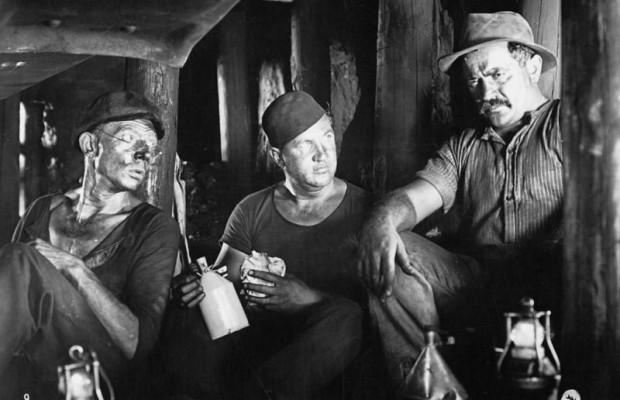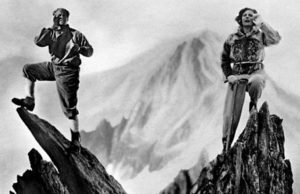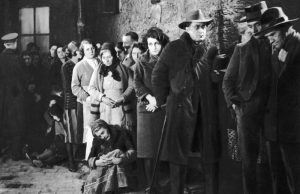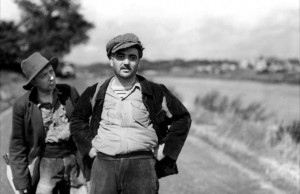Kameradscaft (1931)

Sweeney Steps Out, Private Life of a Cat, A Study in Choreography for Camera, At Land, & Kameradscaft
7th Showing, April 25th, 1949, 8:15 pm
Royal Ontario Museum Theatre
Sweeney Steps Out (USA 1942) 10 minutes Source: N.Y. Museum of Modern Art
Produced by Film.Associates, Inc.
Directed by Joseph Krumgold
Edited by Henwar Rodakiewicz
Made for the N.Y. Zoological Society, Sweeney Steps Out teaches its young hero not only the names of many of the Bronx Zoo’s inhabitants, but the meaning of courage and loyalty as well.
John Kieran’s witty commentary keeps pace with the humor and spirit of this well-made film.
Private Life of a Cat (USA 1947) SO minutes Source: NFS Ottawa
Produced by Alexander Hammid
Original Music by Gene Forrell
Commentator: Maya Deren
The skilled camera of the film documentarian, Alexander Hammid (famous for Crisis, The Nazi Way, Hymn of the Nations with Toscanini, Forgotten Village, and Valley of the Tennessee) transports us here to a feline world. The camera itself is cat-like as it observes and captures an amazing range of feline experience and expression. No humans intrude as we follow “Glamour Girl” and “Joe”, two cats in the Hammid household, through courtship and the birth and rearing of their five kittens. After a month of the nursing and training of her offspring, Glamour Girl turns her attention back to Joe as she resumes her private life on a less strenuous basis.
A Study in Choreography for Camera (USA l945) 5 minutes · Silent
By Maya Deren and Talley Beatty
At Land (USA l944) 16 minutes Silent
Conceived and Directed by Maya Deren
Technical Assistance by Hella Hayman and Alexander Hammid
The Central Figure played by Maya Deren
Maya Deren is one of the foremost present-day film experimenters. Before she was sponsored by a Guggenheim Fellowship for creative film work, she had completed three films and had exhibited them in the Provincetown Playhouse in New York. Her other films include Meshes of the Afternoon (1945) with camera-work by her husband, Alexander Hammid, Ritual in Transfigured Time (1945-46) and Contemplation of Violence (1949). She has written several articles on creative film—making and a chap-book, An Anagram of Ideas on Art, Form, and Film.
Maya Deren is concerned above all with film as a creative, independent art form, quite distinct from the entertainment, the documentary and the educational functions which film has to a measure fulfilled. Her experiments labor toward the extension and development of the form of film itself – that is, film as a time-space medium. She has attempted to create experiences on film out of the very nature of the film instrument – that is, its temporal and spatial resources.
Perhaps A Study in Choreography for Camera is her most completely realized film. In it she has of course dispensed with the formal limitations of the ballet stage or conventional motion picture set and has evolved a new choreographic concept, one that stems from the camera’s mobility and versatility and her own editing principles. “This is in a sense a duct between space and a dancer — a duet in which the camera is not merely an observant sensitive eye, but is itself creatively responsible for the performance.”
At Land deals with a broader field of experience. The movements of one individual constitute the unifying device, not plot or external narrative or character portrayal. Like A Study in Choreography for Camera, it has no dialogue, music or sound effects. “If this film has a theme,” says Miss Deren, “it is the effort of the individual to relate himself to a fluid, apparently incoherent universe.” … “Today man has discovered that that which seemed simple and stable is, instead, complex and volatile; his own inventions have put into motion new forces, toward which he has yet to invent a new relationship – each individual is the centre of a personal vortex, and the aggressive variety and enormity of the adventures which swirl about and confront him are unified only by his personal identity.”
INTERMISSION
During the Intermission a discussion will take place from the stage on the various experimental aspects of these two films by Maya Deren. Members of the executive and of the audience will devote three minutes to the consideration of a single aspect of the films; the discussion will then be thrown open to remarks or questions from the members of the audience; Mr. Roy Clifton will be chairman.
Kameradschaft (Germany 1931) with English titles 85 minutes Source: Canadian Film Archives, NFS Ottawa
Director: G. W. Pabst
Pabst, well—known for his films, The Joyless Street, The Love of Jeanne Ney, The Three Penny Opera, Westfront 1918, White Hell of Pitz Palu, etc., tells in this film of a mining disaster in the French workings of a coalmine on the Franco-German frontier. Founded on fact, it relates how the miners on the German side, breaking through the formal barriers of the frontier, go up to the rescue of their French comrades. Made as propaganda for international co-operation and against war, it remains at the same time one of the outstanding achievements of the early sound period, remarkable for its high degree of naturalism and for its imaginative use of realistic sound.
“Pabst has a fierce international idealism tucked away in his Teutonic interior. It blazes up in this film and adds both power and importance to everything he describes… Pabst’s construction is the one I like best in cinema. He builds his little individual stories only slightly into the march of events. They punctuate it and give it point and whatever the emphasis on lost sons and brothers and lovers, the march of events never ceases to be the principal concern… There are a hundred details of fine direction … and there are effects in the film which tear one to shreds… My only complaint against Pabst is an old one. He means the best things in the world, but he means them sometimes too obviously. He cannot let well alone, but must keep on underlining things already emphasised… ” ~ Grierson on Documentary
***
The results of the first annual competition for the CANADIAN FILM AWARDS have appeared in the press. Gerald Pratley, President of the TFSG and movie critic for CBC will discuss the Awards over CJBC on Saturday, April l6th at 7-50 P.M. The presentation of the Awards will be made by the Prime minister of Canada on April 27th, 1949 in the Little Elgin Theatre in Ottawa.
Members will remember THE LOON’S NECKLACE by Crawley Films, viewed at our December showing: it received the highest honor in the competition. Special awards went to the French—language feature, UN HOM ET SON PECHE, produced by Paul L’hnglais of Quebec Productions, and to Norman McLaren of the National Film Board for his DOTS AND LOOPS, one of his experiments in drawing directly on to film and producing his sound track in the same way. In the theatrical class first honors went to the NFB production, WHO WILL TEACH YOUR CHILD, with the Canadian Cameo Series of Associated Screen News, produced by Gordon Sparling receiving honorable mention: the deftly cut CANADIAN HEADLINES FOR 1948 was selected to represent the series. Two first awards were made in the non-theatrical class: one to the NFB productions, FEELING OF HOSTILITY and DRUG ADDICT. In the animated class, the NFB CHANTONS NOEL won an award, while in the amateur class, two films were awarded honorable mention: SUITE TWO by Dorothy Burritt, Maureen Balfe and Moira Amour and Louis Shore’s MAKING A LIFE MASK. Next Season we plan to include several of these films on our programmes.
A separate article on THE FUNCTIONS OF A FILM SOCIETY is being distributed to members.
In the lobby of the theatre, before the performance, a two—minute colour film made by Louis Shore will be running. This film was made in one day, with very simple equipment and it has served as a valuable teaching aid in instructing children the basic steps to be adopted in making toys, which in later stages can take whatever form the maker fancies. Examples of these “Animules”, designed and made by children will be on display.
Please continue to fill out your evaluation forms: your co-operation is very much appreciated.










Leave a Reply